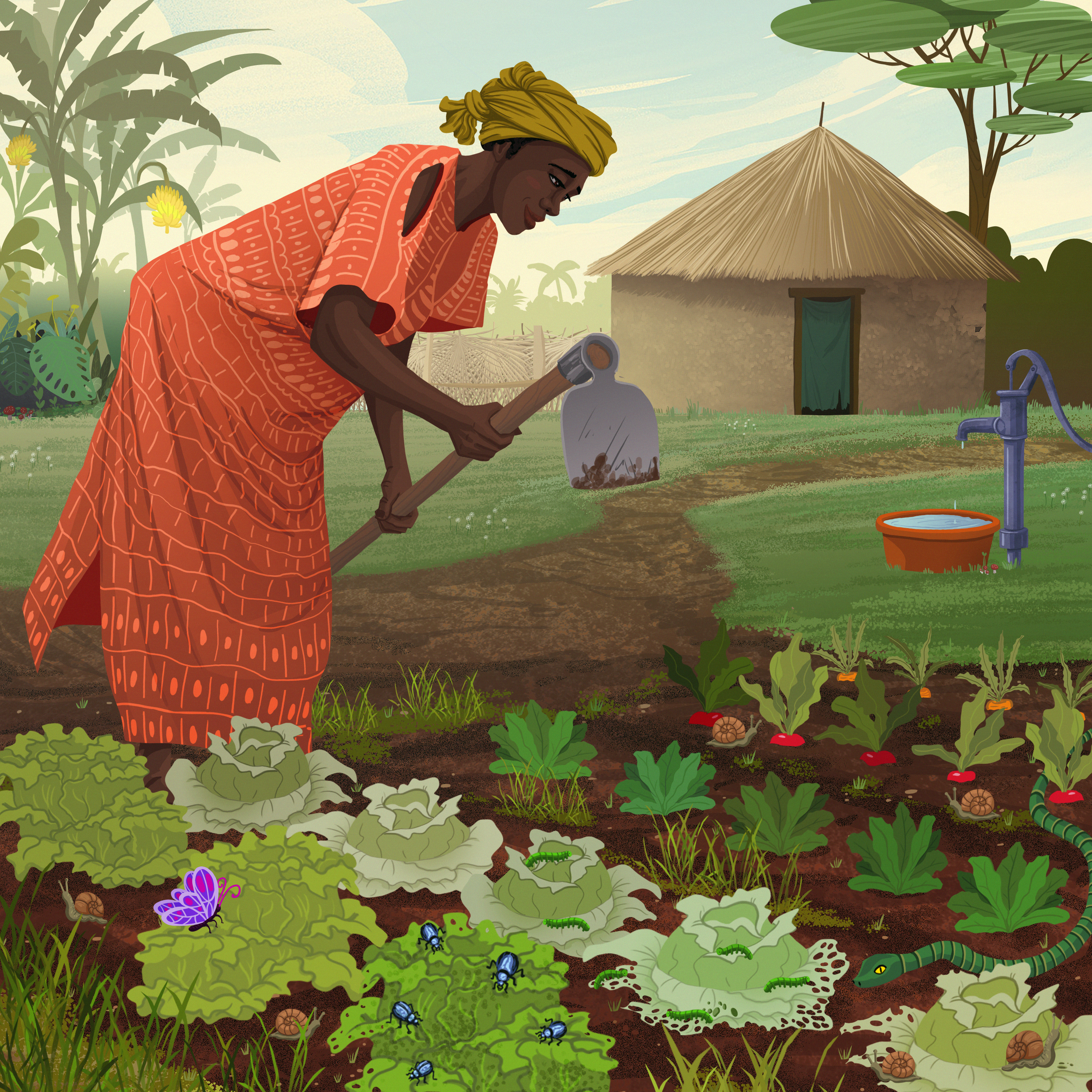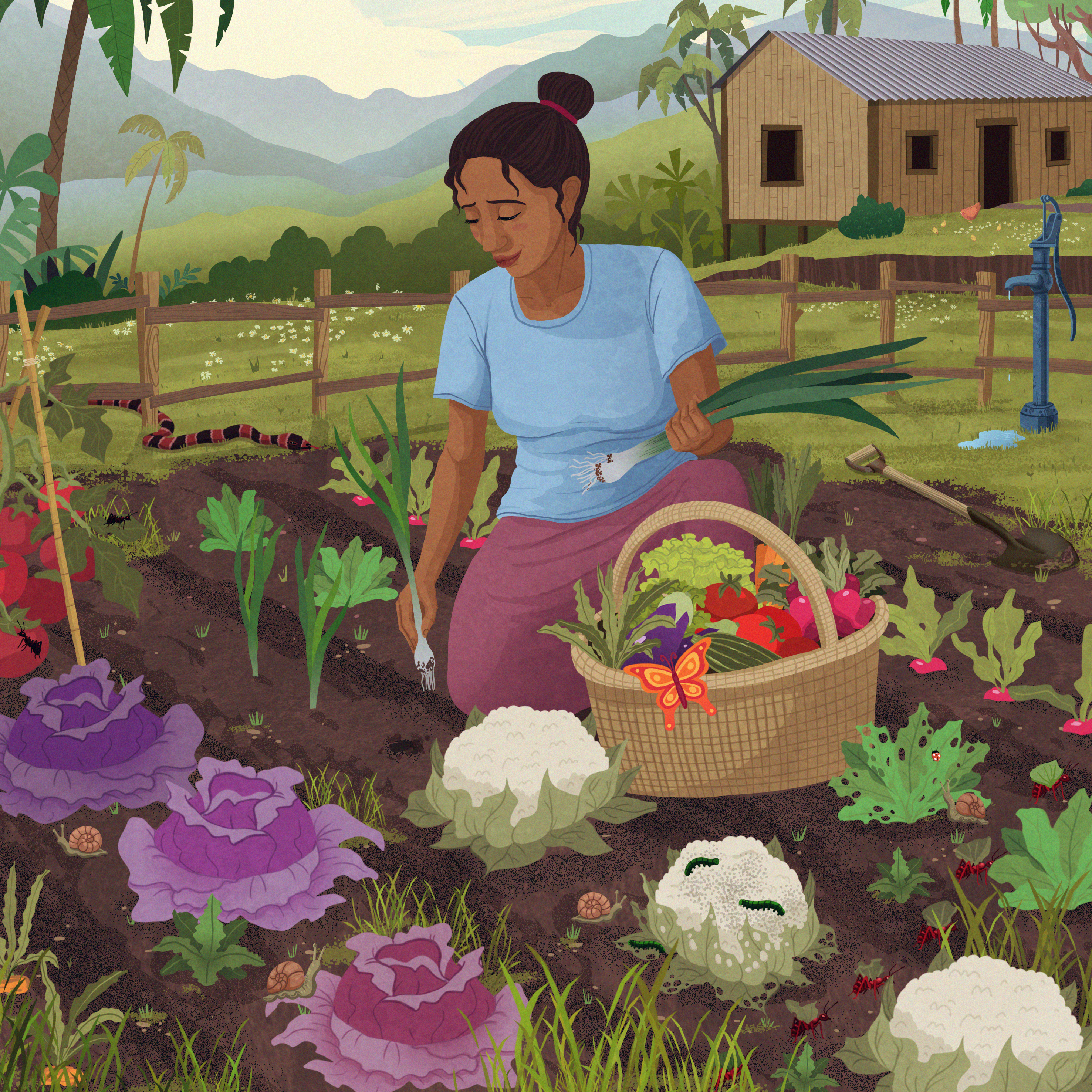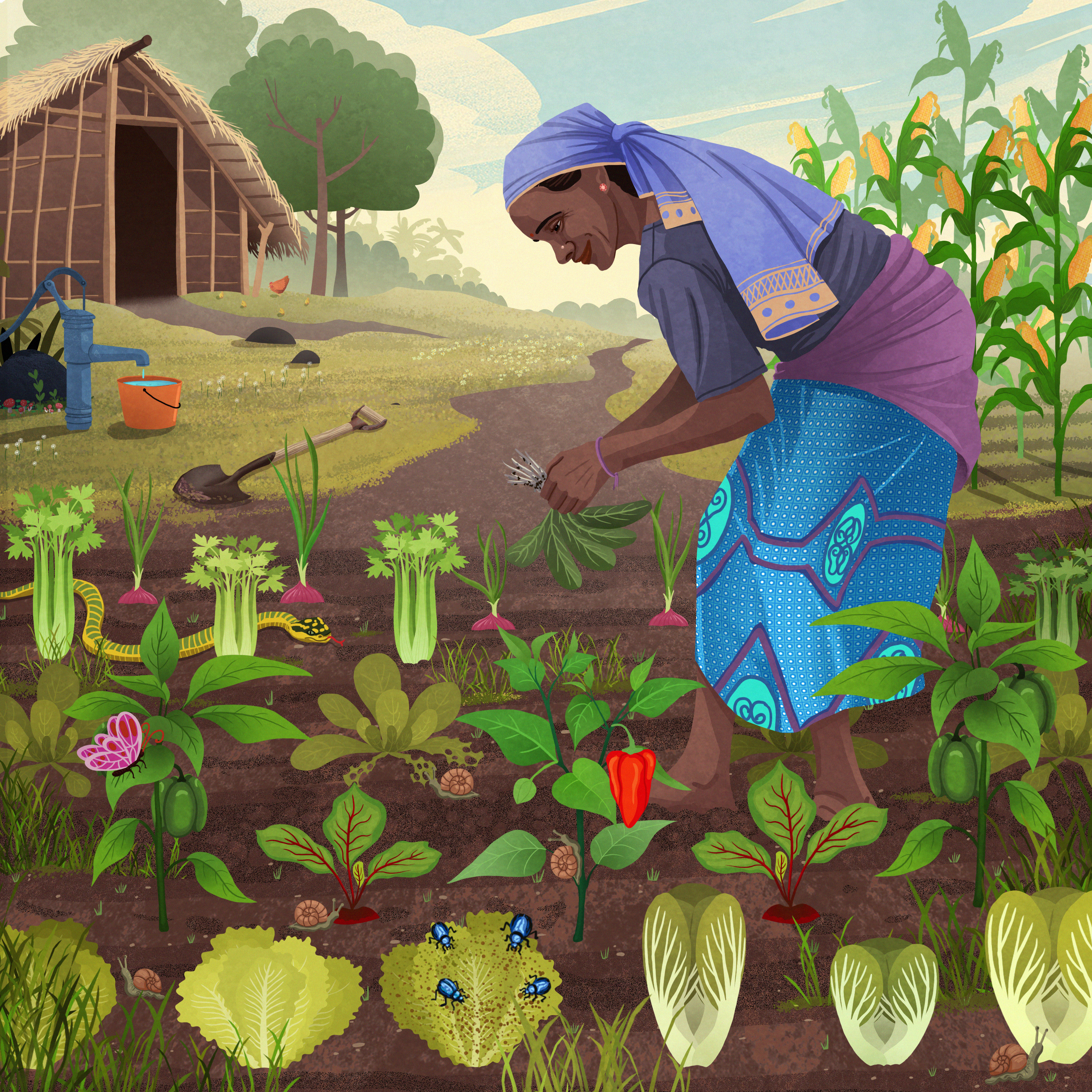Global Child Protection Parenting Curriculum
Year 2, Lesson 12: A Maintained and Healthy Garden: Creating a Plan for Change
Time Needed: 45 minutes
Garden Images:



Index
Teacher Preparation
Introduction
New Ideas
Caregiver Connection
Application/Activity
Reflection
Closing
Teacher Preparation
Objectives
The caregiver will be able to:
- Hear a story about the kingdom of God coming to earth.
- List positive ways that the local community and culture already protect and care for children.
- List ways that the local community and culture could protect and care for children more effectively.
- Create a simple plan to initiate change in the home.
Materials
- Chalkboard and chalk
- Garden image
- Paper
- Pencils
Preparation
- Read the lesson and reflect on how to teach it wisely.
- Skim previous lesson. Prepare to have a quick review at the beginning of class.
- Take time before class to identify some of your community’s current strengths in child protection. Perhaps there is a culture of neighbors looking out for each other’s children or a strong emphasis on family. What cultural values or community practices are already in place to help protect children?
- Take time before class to consider areas your community could protect and care for children more effectively. Do girls feel unprotected outside the home? Are special needs children devalued and unsupported by the culture? Do cultural norms, like child marriage or female genital mutilation, continue to be practiced because of tradition? Is physical abuse of children considered culturally acceptable?
Introduction
5 minutes
![]()
This is our final class on parenting and child protection. We have covered a lot of topics in the last year. We explored such things as how to:
- Release control over our children and promote personal responsibility
- Create and respect healthy boundaries
- Discipline from a place of love
- Identify negative heart attitudes towards the opposite gender
- Allow our daughters (and sons) to come to full maturity before marriage
- Care for children with special needs
- Identify and help children who have experienced trauma
- Promote safety in the digital world
- What is one way this class has helped you to make a positive change as a caregiver? Accept answers.
Take out the Garden image. This is a garden ruled by love. The gardener nurtures and cares for her plants. She protects them from things that bring harm. This gardener has a greater purpose for her garden—she desires for her garden to bless her community.
- How might a healthy, thriving garden bless a community? Accept answers. Possible answers: food, beauty, joy.
Imagine that a new gardener took over. The gardener prefers the name “boss.” This boss has a different purpose for the garden. The purpose is for the boss to gain wealth and status in the community. Instead of ruling with love, the boss desires control and power. The garden becomes bigger and produces more food, but the food is not to be shared, only sold to the highest bidder. Large walls are put around the garden and the only people in the community who are allowed in work for the boss. They are underpaid and mistreated.
- How might the community view the garden differently under this kind of leadership? Accept answers.
The reason we must talk about child protection is because we live in a world ruled by the desire for control and power. This causes children to often be seen as property to be used or objects to be controlled. As caregivers, we have the privilege and responsibility to teach our children their intrinsic worth, protect them from danger and help them find healing and hope when evil is done to them and through them. When our children mature in such an environment of love, they will grow into strong and healthy adults who bless their family and community.
In our world, this can sometimes feel like an overwhelming task. The good news is that we are not alone. God is always present with us. He loves us and our children unconditionally. His love is more powerful than evil.
We also have one another blessing. God created us to receive love and give love to others. Together, we can be an instrument of positive change in our community.
Take out the Garden image again. Today this garden is a picture of our whole community. Together we will explore the answer to this question: How can a group of people who commit to daily receive love and give love to others, have a positive impact in their homes and on their community?
New Ideas
15 minutes
![]()
Today’s scripture is from the book of Isaiah. It is a picture of what happens when God’s love enters our world of evil, pain and suffering. Love always desires what is good for us. So, when love enters our world, good things happen. As I read, whenever you hear an announcement of something good happening, raise your hand.
Read through the passage slowly, allowing time for participants to hear good things and raise their hands. Whenever they hear something, stop and repeat it verbally. Then ask the participants to come up with a motion to remind them of the good news. Repeat the good thing and motion as a class. Possible motions are given below.
Isaiah 61:1-3
1 The Spirit of the Lord and King is on me.
The Lord has anointed me
to announce good news to poor people.
Possible motion: cup hands around mouth, like you are making an announcement. Say, “Announce good news to poor people.”
He has sent me to comfort
those whose hearts have been broken.
Possible motion: hands over heart. Say, “Comfort the brokenhearted.”
He has sent me to announce freedom
for those who have been captured.
He wants me to set prisoners free
from their dark cells.
2 He has sent me to announce the year
when he will set his people free.
Possible motion: hands stretched up in the air. Say, “Set the prisoners free.”
He wants me to announce the day
when he will pay his enemies back.
Possible motion: bring fist down on hand. Say, “God will pay back his enemies.”
Our God has sent me to comfort all those who are sad.
3 He wants me to help those in Zion who are filled with sorrow.
Possible motion: cross arms over chest. Say, “Comfort the sorrowful.”
I will put beautiful crowns on their heads
in place of ashes.
Possible motion: put crown on head. Say, “Replace ashes with a beautiful crown.”
I will anoint them with olive oil to give them joy
instead of sorrow.
I will give them a spirit of praise
in place of a spirit of sadness.
Possible motion: remove hands from face and smile. Say, “Replace the spirit of sadness with the spirit of joy.”
Where God’s love rules and reigns—good news is given to the poor; the brokenhearted are comforted; the captives are set free; God defeats the enemy; joy replaces sorrow; beautiful crowns replace ashes; the spirit of praise replaces the spirit of sadness.
When loves rules a home or community, wrongs are made right, wounds are healed, and all people are seen as valuable and worthy of love.
- What are other things you know are true about love? Accept all answers. Possible answers include: only desires what is good; brings joy; restores hope; is generous; listens for understanding; is patient and kind; does not control or manipulate; brings freedom.
Love is always present, even in the midst of evil. This means love is present and active in our community.
- How have you experienced love in our community? Accept answers.
When considering child protection and the importance of our children growing up in an environment of love, it is helpful to remember the positive, loving ways our community already protects and cares for children.
For the next question, ask participants to get into groups of 3-4. Give groups a few minutes to discuss the question below. Since you have already spent time thinking about this question, consider giving a few examples to the class to help generate ideas. Encourage them to think about times they have personally felt supported by the community in the proper care, nurturing and protection of their children.
- What are ways our community and culture already protect and care for children well?
At the end of the discussion time, ask each group to report back to the whole class.
It is good to remind ourselves of the ways that love is actively present in our community. We are not alone. Our community already has in place support systems to help our children grow into strong and healthy adults who can make wise and loving choices.
But every community has areas where love does not rule. It is also important to identify ways we can grow in the protection and care of our children. Let’s think again about the topics we have covered in this course. We have explored how to:
- Release control over our children and promote personal responsibility
- Create and respect healthy boundaries
- Discipline from a place of love
- Identify negative heart attitudes towards the opposite gender
- Allow our daughters to come to full maturity before marriage
- Care for children with special needs
- Identify and help children who have experienced trauma
- Promote safety in the digital world
- What are areas that our community and culture could protect and care for children more effectively?
Ask participants to return to their groups and discuss the following question. At the end of the discussion, ask each group to report back to the class. Since you have already spent time thinking about this question, consider giving a few examples to the class to help generate ideas. Encourage them to think about times they have personally felt unsupported by the community in the proper care, nurturing and protection of their children.
- How might a commitment to receiving love and giving love to others bring change to one of these areas? Accept answers.
Caregiver Connection
5 minutes
![]()
Isaiah 61 shows us what it looks like for love to come into our broken and hurting world. Love brings change. Wrongs are made right, wounds are healed, hope is restored. God’s love is always at work.
The Bible tells us we are made in God’s image. This means we can love others with God’s love. As caregivers to our children, this is very good news. When we ask God to fill us with his love, he does. When we ask God to help us make a wrong we see in our home or community right again, he guides and directs us. God loves us, our children and our community. His desire is always for our good.
Application/Activity
15 minutes
![]()
Pass out paper and pencils to each participant.
How can we take what we’ve learned and put it into practice in our own lives? Let’s take a few minutes to create a plan of action. A good place to start is our own homes.
- What is one area in your home where you desire to see love bring change? Allow a moment of silence.
On the top of your paper, draw a picture of how you desire love to bring change. For example, you may desire to have a more open, loving relationship with your child. You might draw a large heart inside of a house, to represent love’s growth.
We cannot control how others will act, but we can control our own actions. The best way to help bring our thoughts, feelings and actions under love’s control is to make a daily practice of receiving God’s love. This practice could take on many forms. Here are a few ideas:
- 5 minutes of silence in the morning. Ask God to fill you with his love, tell him what you need and listen for his loving response to you.
- Walk each day and look for beauty in the world. Ask God what it reveals about his love.
- At the end of the day, reflect on where you saw love at work in your life. Give thanks for these moments.
Instruct participants to draw a circle on the left side of the paper. Inside the circle, draw a picture that represents a personal practice of receiving love that they commit to do daily. If any participants can write, they can also write down their ideas.
We cannot give what we do not have ourselves. When we commit to receive love daily, then we can give love to others. Look again at the picture that represents your desire for loving change in your home.
- What is a weekly practice you can start with your family that would help move you towards your goal? Allow a moment of silence.
Instruct participants to draw a circle on the right side of the paper. Inside the circle, draw a picture that represents a family practice that they commit to do weekly. If any participants can write, they can also write down their ideas.
Finally, it is important to remember that we are not alone. We need the support and encouragement of others.
- Can you think of 2 or 3 trusted people in your life who you could turn to for help and support? Allow a moment of silence.
Instruct participants to write names or draw faces on the bottom of the page, to remind themselves of people they can turn to for help.
Reflection
4 minutes
![]()
You have just created a simple plan to begin loving change in your home. Let’s take a moment to talk to God about your plan. Ask for his love to come into your home. Ask him to bless this plan. Ask him to help you. Allow one minute of silence.
Now let’s take a moment to listen for his loving response.
- What does God want to tell you about your family?
Allow one minute of silence.
- Does anyone want to share something they heard in our time of silent reflection? Accept answers.
Closing
1 minute
![]()
As you begin to implement your plan, notice the changes love brings. Those changes most likely will begin in you. Consider telling a trusted friend about your plan and ask for their encouragement and support. Expect God’s love to show up. Remember, God’s love is always at work. When love is present, good things happen.
![]()